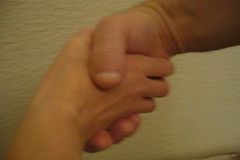I think it's all too easy to assume that everyone knows about Web 2.0. Well, I am always coming across intelligent, well-informed people who don't know about it. So, this 'Rookie' series is for two sorts of people: those who don't know about Web 2.0, and those who do know about Web 2.0 (because they can send the articles to those who don't!).
Web 2.0 is so-called to distinguish it from the original experience of the world wide web. Traditionally, the web has been mainly a publishing medium, but in one direction only: from the publisher to the reader. That's great for making a lot of stuff available to a lot of people; not so great for having an interesting interaction, or 'conversation'.
 Collaboration is what Web 2.0 is all aboutWeb 2.0 is sometimes referred to as the 'read-write web'. This nicely summarises the new web from the old: now you can write to it, ie contribute, rather than just read what someone else has written. You don't have to look very far to find examples of this: just add a comment to this article and you'll be doing it yourself.
Collaboration is what Web 2.0 is all aboutWeb 2.0 is sometimes referred to as the 'read-write web'. This nicely summarises the new web from the old: now you can write to it, ie contribute, rather than just read what someone else has written. You don't have to look very far to find examples of this: just add a comment to this article and you'll be doing it yourself.
Like many delineations, this one blurs at the edges. After all, long before 'Web 2.0' as such was born we had discussion forums to which anyone could contribute once they'd signed up. For a very good analysis of the different types of tools and interactions available, see the article by Miles Berry and Steve Lee in the free ebook Coming of Age: An Introduction to the NEW Worldwide Web, which is available from the 'Free Stuff' page on this website.
The delineations blur at the edges, too, when you have a practical decision to make, as I had recently, in whether or not to include a submission to a book about Web 2.0 projects. For example, one project involves the use of a cell phone and PowerPoint. Not much Web 2.0 in evidence there, you might say. But if the kids had used their own cell phones, and contributed to a SlideShare presentation, say, then it would have been Web 2.0.
In other words, I decided to take a pragmatic rather than a purist approach, a leaf I've taken out of the economists' book. Faced with endless debates about what money is, and whether X is money, near-money, or not money at all, economists have largely adopted the view that if it acts like money, if people use it as money, if people accept it as money, then it must be money.
In a similar way, my view of Web 2.0 is that if something lends itself to collaborative working and can be worked on over the web, let's call it Web 2.0. I'm sure that will upset the purists, but as far as I'm concerned it's a good practical definition which, hopefully, will make sense to 'rookies'. It makes sense to me, and I consider myself a perpetual 'rookie'.
Examples of Web 2.0 applications include blogs, wikis, online presentation tools, online photograph-sharing sites like Flickr and many, many more. For a good introduction to Web 2.0, download and read the aforementioned Coming of Age.
Also available from the same place is the Web 2.0 Projects Book, which contains around 60 projects undertaken by teachers using Web 2.0 applications. Not all of the links work now, but the ideas are still valid.
A brand new edition will soon be available, containing over 100 amazing projects. In fact, it will be officially launched at my seminar at the BETT Show 2010 entitled Amazing Web 2.0 Projects: Real projects in real classrooms with real kids! That would be a good place to gain an introduction to Web 2.0 if you're at BETT this year, but there are other seminars too as well as the Teachmeet event.
But if you can't get to BETT, not to worry: just follow this series and download the new projects book when it's available!
